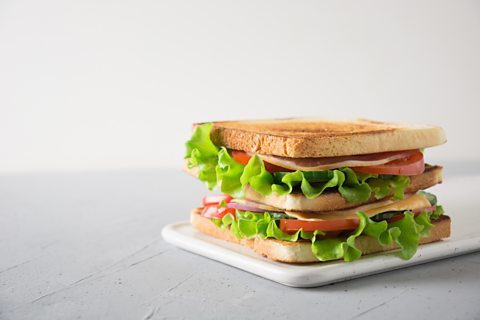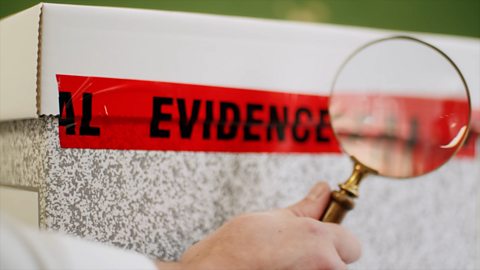Point, Evidence and Explain
Sometimes we donÔÇÖt even pay attention to the evidence about our own lives. Are you sure thatÔÇÖs the way things happened, or are you changing the facts to suit your own version of events?

When making an argument, it is important that you do it in clear and structured way. A tried and trusted method is the Point, Evidence, Explain model:
- make an accurate and relevant point to the topic of discussion
- use factual evidence
- support with an explanation that connects the evidence with the point you are making
Imagine the model as a sandwich, a number of things that are put together to make one meal. You need the bread, meat or cheese, lettuce - all of which constructed together makes a sandwich.
A paragraph works in a similar way. ItÔÇÖs a number of things combined to make up one passage:
- Start with a point that sums up your argument and relates to the question you need to answer.
- Always think how does my point help answer the question.
- To support your point, relevant evidence must be stated. If you do not provide evidence, then how will anybody believe your argument?
- Good evidence means that you can convince your reader that you know what you are talking about in a clear and confident manner.
- Finally, you will need to explain your answer so that it links back to the question.
This is a key part of the model as it will clearly state why your point and evidence answers the question. The explanation is a great opportunity to show how your response answers the question, no matter how obvious it may be after writing down your point and evidence.

Making an argument
LetÔÇÖs look at an example. You are given some information about the Black Death - also known as the Plague, one of the most fatal pandemics ever recorded in human history that caused 75 - 200 million deaths worldwide.
The question is:
Did the Black Death have negative consequences for the church?
To answer the question, you must write a brief report identifying the possible consequences for the church, offer evidence of the consequences and explain if they were negative for the church. Here is an example answer:
The Black Death had negative consequences for the church in England. While the church became richer as people left it money before they died, 66% of priests died, which meant they were replaced with inexperienced people. Additionally people were buried in mass graves, as there was no more space in the cemeteries. As a result, the formerly good reputation of the priests and the church declined. Therefore, the Black Death can be seen as having negative consequences for the church because people lost the respect that they had for it before the Black Death.
First, make an accurate and clear point - ÔÇśThe Black Death had negative consequences for the church in England.ÔÇÖ The point is super clear, simple and is straight to the point with no messing around. DonÔÇÖt try and do too much - just state your point in the clearest and simplest way possible.
Next, provide some evidence to back the point up:
- while the church became richer as people left it money before they died, 66% of priests died, which meant they were replaced with inexperienced people
- people were buried in mass graves, as there was no more space in the cemeteries
Now there are plenty of examples that we could draw upon to prove the point that the Black Death had negative consequences for the church. What you shouldnÔÇÖt do is list them all, one after the other. ItÔÇÖs best to write down one long example or two short examples that are accurately written and clearly demonstrate the point at hand. By reading this example, you can see how the answer gives two very clear examples to support the point that the Black Death damaged the reputation of the church.
Finally, support your evidence and point with an explanation:
As a result, the formerly good reputation of the priests and the church declined. Therefore, the Black Death can be seen as having negative consequences for the church because people lost the respect that they had for them before the Black Death.
This example explanation brings it all together: point, evidence, explain. Most importantly, it demonstrates the reasoning behind the examples given and returns to the point at the start of the answer.
Connectives
One other thing that will help you glue your sentences between the point, evidence and explanation are connectives. These words will help your answer flow and make sense to the reader. Think of it as the butter that you put in your sandwich. Here are some examples of connectives:
| Point | Evidence | Explain |
|---|---|---|
| - Some historians think | - For example | - This had the impact of |
| - Other historians argue | - Firstly | - Therefore |
| - One reason why | - Secondly | - This led to |
| - Another cause | - For instance | - This resulted in |
| - A further factor | - Furthermore | - This caused |
| - A final reason | - Additionally | - This means |
| - It could be argued that |
Evaluating the past

Historians donÔÇÖt always agree in their interpretations of the past. When historians have examined evidence about the past they will sometimes come up with a theory to explain how things happened. For example, having examined the evidence on the Industrial Revolution, a historian might decide that it was a good thing for Britain, based on the economic benefits that it brought. That conclusion is "their theory".
As historians we are sometimes asked to test whether we think a theory is accurate. We will probably be able to find evidence that "supports" the theory but equally, we may find evidence that contradicts the theory. Again, if we look at the Industrial Revolution, a historian might be able to point to the overcrowding in cities, the destruction of the environment and the lack of concern for workers as negative consequences. As students we need to be aware of the potential theories and the arguments that both "support" and "challenge" them.

Test yourself
More on Evidence
Find out more by working through a topic
- count1 of 3

- count2 of 3
